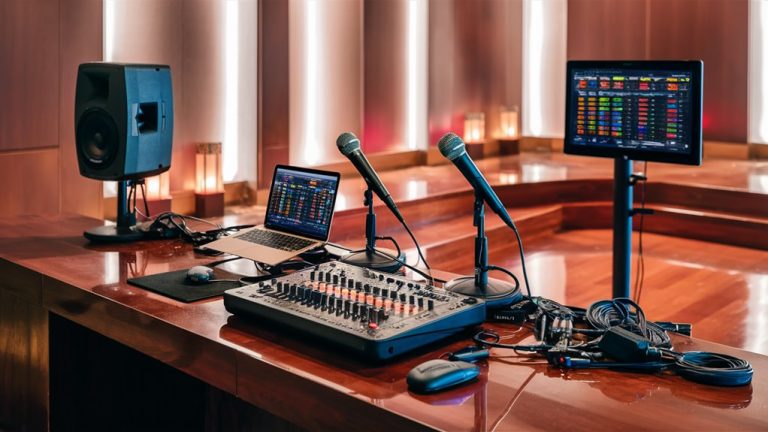
All You Need to Know to Rock Karaoke

Choosing the Best Song
Picking the right tune is key for a great show. Choose songs that fit your 1.5-2 octave voice range. Use a digital tuner to find your range and choose tunes that fit your voice well.
Must-Know Microphone Handling
Learn how to hold the mic by tilting it at a 45-degree angle, two fingers away from your mouth. Let air flow past the mic to keep the sound clear and strong.
Smart Ways to Practice
- Warm-ups every day
- Using a metronome to keep time
- Recording your voice to improve
- Choosing clear places to breathe
Better Breathing Tips
Work on strong breath control to improve your singing. Note where to breathe in your songs to help you sing well and not run out of air.
Own the Stage
- Moving with purpose
- Connecting with the crowd
- Weddings and Anniversaries
- Showing confidence
- Making eye contact
- Managing your energy well
Making Your Show Perfect
Focus on singing clearer, staying on tune, and keeping rhythm. Use feedback from recordings to improve your singing and stage presence.
How to Choose Songs for Your Vocal Range
Understanding Your Singing Range
Voice range is the span of notes you can hit, low to high.
Find your lowest and highest notes with a piano or digital tuner.
People who haven’t trained usually hit 1.5 octaves, but trained ones can do 2-4 octaves.
Finding Your Ideal Singing Range
The tessitura, your comfortable range, is key for selecting songs and singing well.
When choosing songs, notice how the melody moves, especially with high notes or big jumps that might make singing tough.
Adjusting Songs to Suit Your Voice
Changing the key of the song can help if it’s not right for you.
Modern karaoke apps let you adjust the key while keeping the pace and melody correct.
Things to Think About When Choosing a Tune:
- Find the highest and lowest notes
- Check long notes
- Consider the melody’s ups and downs
- Feel how the entire song goes
- Change the key if needed
Keeping Your Voice Safe
Singing correctly means selecting suitable tunes and not overdoing it. This maintains your voice, prevents strain, and helps you sing well each time.
Mastering the Mic
Proper Microphone Use in Karaoke
Using the mic correctly makes you sound great. Knowing how to hold and maneuver the mic lets your voice come out strong without distortion.
Best Ways to Hold the Mic
Hold the mic at a 45-degree angle, not too close or far. This helps avoid harsh sounds and lets your voice fill the room.
Managing Your Mic Grip
Hold the middle of the mic with your primary hand and keep your wrist flexible to move it as needed.
Making Your Sound Clear
Pass air across the mic, not into it, for a clear sound. Keep the mic steady throughout the song to even out your voice.
Practice Makes Perfect: Excelling at Karaoke

Essential Karaoke Practice Tips
Systematic practice is a must for those who want to excel on the karaoke stage.
Recording and Checking Your Progress
- Record your practice
- Check your timing and sound
- Monitor your volume
- Practice with authentic karaoke tracks
- Use a metronome to perfect the rhythm
Enhancing Voice Skills
- Clear enunciation through how you shape vowels
- Emphasis on consonants
- How you position your soft palate
- Switching between head and chest voice
- Expanding your range
Improving Your Performance
- Move intentionally
- Practice in the mirror
- Enhance your gestures
- Build your stage presence
- Maintain strong vocals while moving
Managing Your Breath for Strong Vocals
Basics of Diaphragmatic Breathing
Breath control distinguishes outstanding karaoke singers by setting a solid foundation for lasting vocals and consistent pitch.
Key Breathing Exercises
- Inhale for 4 counts, expand your belly
- Hold for 2 counts
- Visit more Website
- Exhale for 6 counts, contract your belly
- Engage your side muscles to strengthen breath support
Tips for Breathing During Performances
Sustain long notes with steady breaths using your belly muscles.
The appoggio technique keeps pressure under your vocal cords consistent, ensuring accurate pitch as you sing.
Advanced Breathing Tips
- Breathe intentionally at natural pauses in the lyrics
- Maintain steady airflow by controlling muscle contractions
- Keep your belly support consistent
- Choose precise moments to breathe
Starring in Your Show: A Guide to Masterful Stage Presence
Take Command of Your Stage Area
Where you stand is crucial for a powerful act. Stand centrally with a 45-degree angle toward the audience to project your voice effectively and engage them fully.
Mastering Body Movement
Understand your body movements by focusing on motions originating from your core. Your solar plexus should guide your body’s movements.
Enhancing Your Performance Appeal
Integrate dance moves seamlessly with your song by synchronizing your hand movements with the rhythm.
- Employ strategic gazes
- Express boldly during intense sections and soften during quieter moments

